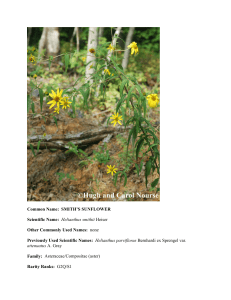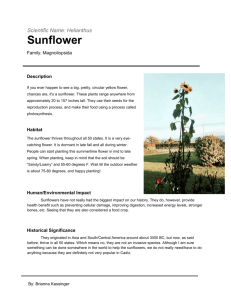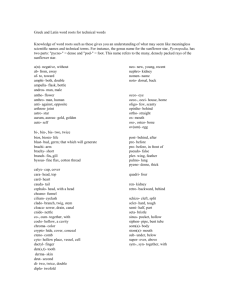Barstow woolly sunflower Eriophyllum mohavense PLANTS Legal Status
advertisement

DRAFT March 2, 2012 PLANTS Barstow woolly sunflower (Eriophyllum mohavense) Barstow woolly sunflower (Eriophyllum mohavense) Legal Status State: None California Rare Plant Rank: 1B.21 Federal: Bureau of Land Photo courtesy Xeric Specialties Management Sensitive Critical Habitat: N/A Recovery Planning: N/A Notes: In 1993, the U.S. Fish and Wildlife Service (USFWS) determined that proposing to list Barstow woolly sunflower as endangered or threatened may have been appropriate, but sufficient data on biological vulnerability and threat were not available at that time to support a proposed rule (58 FR 51144–51199). Taxonomy Barstow woolly sunflower (Eriophyllum mohavense) was originally described by Ivan Murray Johnston in 1923 under the synonym Eremonanus mohavensis (Johnston 1923; IPNI 2005), but soon included in Eriophyllum by Jepson (1925, p. 1117). Barstow woolly sunflower is in the aster family (Asteraceae) (Jepson Flora Project 2011). It is an annual herb standing approximately 1 to 2.5 centimeters (0.4 to 1 inch) in height. A full physical description of the species can be found in The Jepson Flora Project (2011). Distribution and Occurrences within the Plan Area General This species is endemic to the west-central portion of California's Mojave Desert (NatureServe 2010; Jepson Flora Project 2011). According to NatureServe (2010), Barstow woolly sunflower is 1 1B: Rare, threatened, or endangered in California and elsewhere; X.2: Fairly endangered in California. 1 6668 March 2011 DRAFT March 2, 2012 PLANTS Barstow woolly sunflower (Eriophyllum mohavense) restricted to a range within a 30-mile radius of Barstow in San Bernardino and Kern Counties. The species' elevation range extends from 1,640 to 3,150 feet (CNPS 2011). All of the 63 total California Natural Diversity Database (CNDDB) occurrences are in the Plan Area (Figure SP-P712). Historical The historic range of the Barstow woolly sunflower is likely similar to its current range today (CDFG 2012). There are 63 total CNDDB occurrences in the Plan Area, approximately 48% (29) of which have been recorded prior to 1990 or are considered possibly extirpated or are not dated (CDFG 2012). Additional occurrences of Barstow woolly sunflower may be extirpated without having been updated in the CNDDB (NatureServe 2010). These occurrences extend from the area around Barstow northwest to the Almond Mountains foothills, west to the area around Kramer Junction, and south to Stoddard Mountain (CDFG 2012). Recent There are 63 total CNDDB occurrences in the Plan Area. The majority of the 34 CNDDB occurrences recorded since 1990 that are presumed extant are located in the vicinity of Kramer Junction on Edwards Air Force Base. Occurrences extend farther west, approximately 5.5 miles east of the Mojave Airport, and near Buckhorn Lake about 1 mile north of the Kern–Los Angeles County line. Records farther east are from near Opal and Lane Mountains, as well as Barstow (Figure SPP712). Of the current occurrences, approximately 53% are on lands owned by the Department of Defense (DOD) on Edwards Air Force Base, 26% are on Bureau of Land Management (BLM) land, and 21% are on lands that are privately owned or are likely privately owned (CDFG 2012). Natural History Habitat Requirements Barstow woolly sunflower prefers sandy or rocky areas within chenopod scrub, Mojavean desert scrub, creosote bush scrub, and also 2 6668 March 2011 DRAFT March 2, 2012 PLANTS Barstow woolly sunflower (Eriophyllum mohavense) occurs on playas (NatureServe 2010; CNPS 2011; Jepson Flora Project 2011). This species prefers bare areas with little soil that frequently contain a shallow subsurface caliche layer (BLM 2005). Table 1. Habitat Associations for Barstow Woolly Sunflower Land Cover Type Chenopod scrub, Mojavean desert scrub, Creosote bush scrub, and Playas Habitat Designation Primary habitat Habitat Parameters Sandy or rocky places, 1,640– 3,150 feet Supporting Information CNPS 2011; NatureServe 2010 Reproduction Barstow woolly sunflower is a very small annual plant that blooms from March to April or May, then goes to fruit in May (CNPS 2011; Jepson Flora Project 2011; NatureServe 2010). There is no information available regarding pollinators, seed dispersal, seed germination, or seedling establishment. Ecological Relationships Barstow woolly sunflower plants are very small (0.4 to 1.0 inch tall) and tend to be clumped together. As an annual, germination and establishment of this species is dependent on the amount and timing of winter and spring rains. Population Status and Trends Global: Declining (NatureServe 2010) State: Imperiled (NatureServe 2010) Within Plan Area: Imperiled (NatureServe 2010). In 2006, there were approximately 10,600 known Barstow woolly sunflower individuals (NatureServe 2010). The 2011 CNDDB includes 61 occurrences for this species, although this estimate includes 3 6668 March 2011 DRAFT March 2, 2012 PLANTS Barstow woolly sunflower (Eriophyllum mohavense) occurrences that are historic (prior to 1990) or possibly extirpated (CDFG 2011). Population trends for this species are unknown. Threats and Environmental Stressors Threats to Barstow woolly sunflower include energy and subdivision development, sheep grazing, off-road vehicle use, highway and road improvements and building, mining, dumping, and pipeline construction (NatureServe 2010; CNPS 2011). Of these threats, those of primary concern include energy development, sheep grazing, offroad vehicles, and highway improvements (NatureServe 2010). According to NatureServe (2010), several Barstow woolly sunflower sites may be extirpated, but their status has not been reported to the CNDDB. Currently, only one CNDDB occurrence is recorded as possibly extirpated (CDFG 2011). Conservation and Management Activities The BLM has established a 314-acre botanical Area of Critical Environmental Concern (ACEC) northeast of Kramer Junction to protect the Barstow woolly sunflower in the West Mojave Plan Area. This ACEC has a perimeter fence that offers excellent protection from human impacts. Although this ACEC protects a relatively large population of Barstow woolly sunflower, it represents only a small proportion of the overall species’ range (BLM 2005). Management areas at Haystack Butte and Leuhman Ridge on Edwards Air Force Base support Barstow woolly sunflower. Another management area consisting of undeveloped land north of Mercury Boulevard also supports this species (Edwards Air Force Base 2002). Data Characterization Little is known about the occurrences, distribution, population status, and ecology of Barstow woolly sunflower due to its ephemeral life history and occurrences primarily on inaccessible private land. Many of the occurrence points are relatively old and need to be updated (NatureServe 2010). Nearly half (29 of 61) of the CNDDB occurrences were recorded prior to 1990 or are not dated (CDFG 2011). 4 6668 March 2011 DRAFT March 2, 2012 PLANTS Barstow woolly sunflower (Eriophyllum mohavense) Management and Monitoring Considerations Protection of the areas where Barstow woolly sunflower are known to occur is important to maintain viable populations of the species (NatureServe 2010). Barstow woolly sunflower would likely benefit from the elimination of off-road vehicle use and sheep grazing in occupied areas. In addition, focused surveys for this species should be conducted in suitable habitat where it is likely to occur, including investigating the status of records of the species where the status is uncertain and that may have been extirpated. Management and monitoring are complicated by the year-to-year fluctuations in population size in response to rainfall. Furthermore, Barstow woolly sunflower is very difficult to detect once it has gone to fruit (typically in May), which may affect population records and estimates (NatureServe 2010). Predicted Species Distribution in Plan Area There are approximately 228,143 acres of modeled suitable habitat in the Plan Area. Modeled suitable habitat occurs in the High Desert Plains and Hills, Lucerne-Johnson Valleys and Hills, and Mojave Valley-Granite Mountains ecoregion subsections from 2,200 to 3,600 feet. Suitable habitat includes desert playa, inter-mountain dry shrubland and grassland, lower bajada and fan Mojavean-Sonoran desert scrub, and shadscale-saltbush cool semi-desert scrub with sandy or rocky substrates. Literature Cited 58 FR 51144–51199. Notice of Review: “Endangered and Threatened Wildlife and Plants; Review of Plant Taxa for Listing as Endangered or Threatened Species.” September 30, 1993. BLM (Bureau of Land Management). 2005. Final Environmental Impact Report and Statement for the West Mojave Plan. A Habitat Conservation Plan and California Desert Conservation Area Plan Amendment. January 2005. 5 6668 March 2011 DRAFT March 2, 2012 PLANTS Barstow woolly sunflower (Eriophyllum mohavense) CDFG (California Department of Fish and Game). 2012. California Natural Diversity Database (CNDDB). GIS Data for the Plan Area. Sacramento, California: CDFG. February 2012. CNPS (California Native Plant Society). 2011. Inventory of Rare and Endangered Plants (online edition, v8-01a). Sacramento, California: California Native Plant Society. Accessed February 2011. http://www.cnps.org/inventory. Edwards Air Force Base. 2002. Integrated Natural Resources Management Plan for Edwards Air Force Base, California. Mojave Desert Ecosystem Program. Environmental Management Office, Edwards Air Force Base California. October 2002. Accessed March 2011. www.mojavedata.gov/ documents/docs/PLN_Intgrtd_Nat_Res_Mngmnt_Pln_EAFB_20 02.pdf. IPNI (International Plant Names Index). 2005. “Plant Name Details” and “Author Details.” Accessed February 10, 2011. http://www.ipni.org/ipni/idPlantNameSearch.do?id=933962&back_page=%2Fipni%2FeditSimplePlantNameSearch.do%3 Ffind_wholeName%3DEriophyllum%2Bmohavense%26output _format%3Dnormal. Jepson Flora Project. 2011. “Eriophyllum mohavense.” The Jepson Online Interchange: California Floristics. Berkeley, California: University of California. Accessed February 2011. http://ucjeps.berkeley.edu/interchange.html. Jepson W.L. 1925. A Manual of the Flowering Plants of California. Berkeley and Los Angeles, California: University of California Press. Johnston, I.M. 1923. “Diagnoses and Notes Relating to Spermatophytes Chiefly of North America.” Contributions from the Gray Herbarium of Harvard University 68:101–104. NatureServe. 2010. “Barstow Wooly-Sunflower.” “NatureServe Explorer: An Online Encyclopedia of Life” [web application]. Version 7.1. Arlington, Virginia: NatureServe. Accessed February 2011. http://www.natureserve.org/explorer. 6 6668 March 2011 Species Range in California Utah Nevada ! ( ! ( Current Occurrence Point Historic and Unknown Occurrence Point Note: Occurrence point size graphically represents the precision level code for the data point but is not scaled geographically. ( ! !! ( ( ( ! ! ( ! ( ! ! ( ! ( ( ! ( ! ( !( ! ( ( ! ( ! ( ! ( ! ! ( ( ! ( ! ! ( ! ( ( (! ! ( ! ( ! (! ( (! ! (! ! (! ( ( ! (! ! ( (! (! (! (! (! (! (! ! ( ! ( ( ! ! ( ! (( ! !! ( ( ! ( ( ! ( ! ( ! ( ! ( ( ! (( ! (! ! ( ! ( ! (! ! (! ! ( ! ( ( ! ! ( ( ! Arizona ( ! ( ! P a c i f i c Z:\Projects\CEC\j6668_DRECP\MAPDOC\MAPS\BaselineBioReport\SpeciesProfiles O c e a n I ME X IC O 0 12.5 25 Miles Sources: DRECP Species Occurrence Database (2011), CNPS (2011), CEC (2010), USGS (2010), ESRI (2010) FIGURE SP-P7 Barstow Woolly Sunflower Occurrences in the Plan Area (N=63) Desert Renewable Energy Conservation Plan (DRECP) Baseline Biology Report





